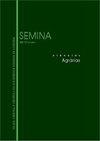Influence of rootstocks for Sangiovese vineyards in a high-altitude region of Santa Catarina State, Brazil: Impact on sensory and quality characteristics of wines
IF 0.5
4区 农林科学
Q4 AGRICULTURE, MULTIDISCIPLINARY
引用次数: 0
Abstract
Adapting grape varieties to new viticultural regions requires studying the influence of rootstock on wine quality. This study aimed to identify rootstocks that most enhance the enological characteristics of grapes of the Sangiovese variety grown in the high-altitude region of Santa Catarina. The experiment was set up as a completely randomized design in a factorial scheme. Factor A represented the vintages (2019 and 2020), while Factor B denoted the rootstocks: ‘101-14 Mgt’, ‘Harmony’, ‘IAC 572’, ‘Paulsen 1103’, and ‘VR 043-43’. We assessed the physicochemical and sensory characteristics of wines from both vintages. Wines from the ‘IAC 572’ and ‘VR 043-43’ rootstocks had the lowest alcohol concentrations. The ‘VR 043-43’ rootstock contributed to the highest titratable acidity in the 2020 vintage wines. Additionally, wines from 2020 displayed a more vivid red color than their 2019 counterparts. We deduced that the Sangiovese wine quality is affected by the cultivation year. Sensory evaluations revealed that the tested rootstocks did not considerably alter the overall balance of the wine. However, the ‘101-14 Mgt’ and ‘Harmony’ rootstocks notably increased the alcohol concentration and phenolic compound levels in Sangiovese wines.巴西圣卡塔琳娜州高海拔地区桑娇维塞葡萄园的砧木影响:对葡萄酒感官和品质特征的影响
使葡萄品种适应新的葡萄产区需要研究砧木对葡萄酒品质的影响。本研究旨在确定在圣卡塔琳娜高海拔地区种植的桑娇维塞品种葡萄的酿酒特性。本试验采用完全随机设计的析因方案。因子A代表年份(2019年和2020年),而因子B表示砧木:' 101-14 Mgt ', ' Harmony ', ' IAC 572 ', ' Paulsen 1103 '和' VR 043-43 '。我们评估了这两个年份葡萄酒的物理化学和感官特性。来自“IAC 572”和“VR 043-43”砧木的葡萄酒酒精浓度最低。“VR 043-43”砧木是2020年份葡萄酒中可滴定酸度最高的品种。此外,2020年的葡萄酒比2019年的葡萄酒呈现出更鲜艳的红色。我们推断桑娇维塞葡萄酒的品质受栽培年份的影响。感官评价显示,测试的砧木并没有显著改变葡萄酒的整体平衡。然而,“101-14 Mgt”和“和谐”的砧木显著提高了桑娇维塞葡萄酒的酒精浓度和酚类化合物水平。
本文章由计算机程序翻译,如有差异,请以英文原文为准。
求助全文
约1分钟内获得全文
求助全文
来源期刊

Semina-ciencias Agrarias
农林科学-农业综合
CiteScore
1.10
自引率
0.00%
发文量
148
审稿时长
3-6 weeks
期刊介绍:
The Journal Semina Ciencias Agrarias (Semina: Cien. Agrar.) is a quarterly publication promoting Science and Technology and is associated with the State University of Londrina. It publishes original and review articles, as well as case reports and communications in the field of Agricultural Sciences, Animal Sciences, Food Sciences and Veterinary Medicine.
 求助内容:
求助内容: 应助结果提醒方式:
应助结果提醒方式:


